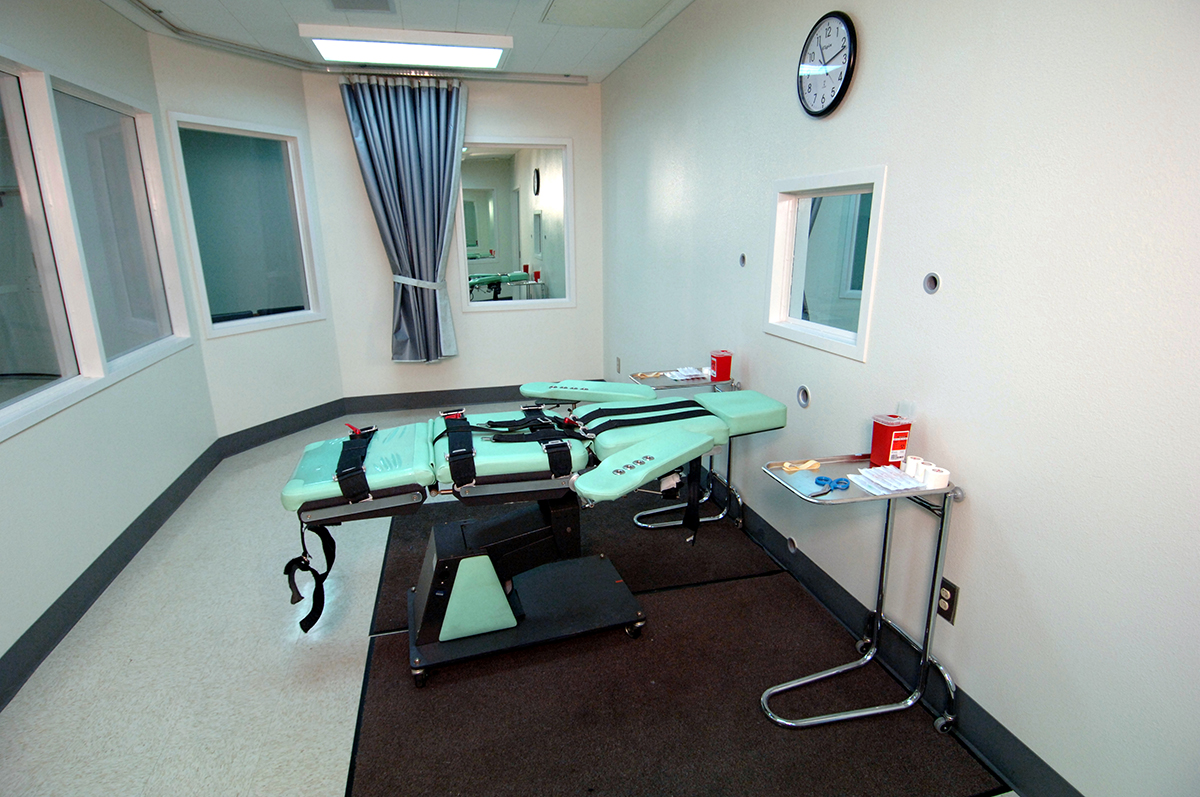Against
“He or she will pay for their choice to kill, whether or not they are given the death sentence.”
 In 1976, capital punishment was reinstated in the United States, four years after it was struck down. Since then, this topic has been extremely controversial. States have argued over whether or not this was the humane and/or productive way to fix the rate of crime in the country. In my opinion, it has been proven tenfold that this process is neither productive, cost-effective nor morally right.
In 1976, capital punishment was reinstated in the United States, four years after it was struck down. Since then, this topic has been extremely controversial. States have argued over whether or not this was the humane and/or productive way to fix the rate of crime in the country. In my opinion, it has been proven tenfold that this process is neither productive, cost-effective nor morally right.
According to the Death Penalty Information Center in Mississippi, taxpayers spend $102.27 per day to house a death row inmate, as opposed to $41.61 per day for other inmates. California could save $1 billion over five years by replacing the death penalty with permanent imprisonment. People wonder why it’s so expensive to live in the U.S. The death penalty may well be a large part of that problem.
Not only is this way of conviction expensive, but how can one be sure that the person being executed isn’t innocent? Sure, there are plenty of circumstances where the evidence stacks too high for anyone to mistake the difference between the innocent and the guilty. But, at the same time, we as humans are prone to making mistakes and being easily deceived due to things such as racism, biases, preconceived notions, etc.
For example, when the jury is chosen for a trial, every person is asked if there is anything that would interfere with their ability to be fair and impartial whilst making their decision on what should happen to those involved in the case. While humans are fallible, they are also deceivers. For all we know, every person put on jury for a case considering the death penalty could be set on terminating the life of the accused.
According to Amnesty International, since 1973 over 130 people have been released from death rows throughout the country due to evidence of their wrongful convictions. In 2003 alone, 10 wrongfully convicted defendants were released from death row.
One example of these horribly wrongful convictions lies in Jonathon Hoffman’s story. He was convicted and sentenced to death in 1995 for killing the owner of a jewelry store. The main witness was Hoffman’s cousin. However, he made deals with the prosecutors for testifying against his cousin. Twelve years later, he came clean and confessed that he just wanted to get back at his cousin for owing him money.
Putting all facts aside, let us look at this from a religious point of view. Are we God? Seeing as that answer is a resounding, “No,” what rights have we to decide who lives and who dies? Granted, the person being accused of murder had no right to make that decision either, but I am a firm believer in the saying, “Everything happens for a reason.” And he or she will pay for their choice to kill, whether or not they are given the death sentence.
I am in no way trying to change the point of view of my readers. I am simply stating my opinion and hoping that it will perhaps shed some new light on the situation for a few people. So next time a capital punishment case is covered on television or in the newspaper, think twice before automatically condemning them to capital punishment. There is always a better option than murder.
For
“Such a terrible offense can only be rectified by offering the life of the murder back to God.”
 As people, one of the most important things we can do is ask questions about the world we live in and weigh the arguments regarding people’s belief systems — even if you believe the same way they do. Asking these questions and playing devil’s advocate is a great way to become more cemented in your beliefs. And knowing that you can adequately defend your beliefs will bring you a great sense of satisfaction when you are challenged. As it happens, doing this kind of thing is one of my favorite activities and I would like to counter last week’s column regarding capital punishment. I would also like to say that I am largely anti-capital punishment primarily for reasons based upon my faith and this article is purely for recreational purposes. I also acknowledge many realities concerning the topic.
As people, one of the most important things we can do is ask questions about the world we live in and weigh the arguments regarding people’s belief systems — even if you believe the same way they do. Asking these questions and playing devil’s advocate is a great way to become more cemented in your beliefs. And knowing that you can adequately defend your beliefs will bring you a great sense of satisfaction when you are challenged. As it happens, doing this kind of thing is one of my favorite activities and I would like to counter last week’s column regarding capital punishment. I would also like to say that I am largely anti-capital punishment primarily for reasons based upon my faith and this article is purely for recreational purposes. I also acknowledge many realities concerning the topic.
The first thing last week’s column pointed out was the amount of money that Mississippi taxpayers spend on housing death row inmates as opposed to normal inmates. The amount was $102.27 per day for death row and $41.61 per day for other inmates. At first this is indeed a shocking statistic if Mississippi is representative of the U.S. — it seems we spend over two times as much money keeping people in death row than we do other inmates. The column suggests that we use life imprisonment as an alternative. But we fail to realize one thing: people on death row are there for a shorter time than people with a life sentence.
According to the Bureau of Justice Statistics, the average time between sentencing and execution for death row inmates is 15 years (rounding up from 178 months) as of 2010. They also report that there is a sharp peak in the age distribution of murderers between the ages of 18 and 30. From this we can infer that the average cost of putting someone on death row for Mississippi taxpayers will be will be $560,000 per inmate if we round up. The Central Intelligence Agency reported in 2010 that the average human life expectancy in the United States is 78.2 years (both male and female, but it’s important to note that prison inmates are disproportionately male). In order to calculate the cost of an inmate we take 78.2 and subtract their age, then multiply that number by days in a year and take the product multiplied by cost per day. If we accept the alternative of life imprisonment and calculate the then Mississippi taxpayers will be paying at the least on average $732,000 per 30-year-old convicted inmate (rounding down) over the course of their life in prison and at the most on average $914,000 per 18-year-old convicted inmate (rounding down again) over the course of their life in prison.
The column last week mentioned that people wonder why it’s so expensive to live in the U.S and mentioned the death penalty as a cause. Perhaps capital punishment is a part of that problem but we can now say for certain that, at least in Mississippi, housing permanently imprisoned inmates is a far bigger one.
The column also asked how we can be certain that the person being executed isn’t innocent, as humans are prone to deceit and mistakes. It also mentions the case in North Carolina of how Jonathon Hoffman was wrongly convicted on a charge of first degree murder and robbery that he committed with his cousin. It mentions how Hoffman’s cousin wrongfully testified against him in open court and how Hoffman was wrongfully convicted of those charges. But Hoffman and his cousin weren’t actually innocent of committing the crime — a jewelry store was still robbed and a man, Danny Cook, still murdered. But Hoffman was released on a mistrial because his cousin accepted money and immunity from an attorney to testify against Hoffman without the judge’s and jury’s knowledge. Hoffman’s cousin eventually recanted his testimony and received his just desserts for his deception.
Hoffman was released from death row and prison because of a mistrial for a crime that he, at least in part, actually committed. He now walks free.
There is a huge difference that the law recognizes between those “legally” innocent and those actually innocent. Yes, there is a difference between “I had no connection to the murder” cases and “I did it but I got off because of legal error” cases. Many death penalty opponents tend to combine these two conflicting groups to increase their “innocents” number.
The column last week mentions Amnesty International in citing the number of people released from death row in the U.S since 1973 (130 inmates). Amnesty International, an anti-death penalty group, draws this statistic from The Death Penalty Information Center (DPIC), another anti-death penalty group, who conducted the study, thereby negating objective confidence in the results. Richard Dieter, head of the DPIC, has confirmed, again, what their “innocent” means:
“. . . according to death penalty opponents, who say they make no distinction between legal and factual innocence because there is no difference between the two under the law and because there is no objective way to make such a determination. They’re innocent in the eyes of the law,’ Dieter said. ’That’s the only objective standard we have.’
The number of people convicted who were actually innocent and had no connection to the crime when compared to the other group is virtually non-existent.
The very fact that more and more people are being released from death row is proof that the number of wrongfully convicted (not innocent) people on death row is becoming smaller and smaller and the proportion of properly convicted inmates is growing larger. If the trend continues, then soon the number of wrongfully convicted people will also be virtually non-existent.
The column also weighs things in a religious perspective, asking if we are God and what rights do we have to decide who lives and dies. We obviously aren’t God and to believe as such would be the height of arrogance. But we do have a responsibility to society and its people to deliver justice to those who make that decision under incriminating circumstances. Humans are made in the image of God and capital punishment instills within people a respect for that image. Human life is sacred; to destroy human life is to attack the image of God. Such a terrible offense can only be rectified by offering the life of the murderer back to God.
Many death penalty opponents play up the angle that human life is sacred but without such a standard that calls for capital punishment, human life would be cheapened and humane causes such as civil rights, gender rights and children’s rights would suffer.
Many death penalty opponents also tend to play up the recipients of capital punishment as victims of the justice system’s failures and victims of the targets of vengeance from the families of the people they killed.
I agree that the justice system has flaws that need to be fixed, and there are many people and more than a handful of activist groups who are trying to make that happen. And I make no concession to the belief that vengeance is a human institution that should be freely exercised but I am not so naïve to believe that justice cannot serve as an adequate substitute for people. Justice began with revenge and still revenge is the only justice some people will ever receive.













[…] See Original Article Here […]
[…] See Original Article Here […]